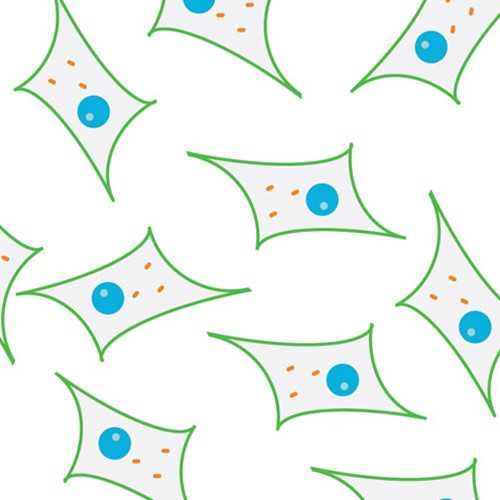Canine Hemangiosarcoma Cell Line (DAL-4)
Dal-4 is a canine hemangiosarcoma cell line derived form a tumor in the spleen of a 7-year old male Dalmatian.
Hemangiosarcoma is a rapidly growing, highly invasive variety of cancer, occurring commonly in dogs. It is a sarcoma arising from the lining of blood vessels. A frequent cause of death is the rupturing of this tumor, causing the patient to rapidly bleed to death.
From the laboratory of Jaime F. Modiano, VMD, PhD, University Minnesota, Twin Cities.
Dal-4 is a canine hemangiosarcoma cell line derived form a tumor in the spleen of a 7-year old male Dalmatian.
Hemangiosarcoma is a rapidly growing, highly invasive variety of cancer, occurring commonly in dogs. It is a sarcoma arising from the lining of blood vessels. A frequent cause of death is the rupturing of this tumor, causing the patient to rapidly bleed to death.
From the laboratory of Jaime F. Modiano, VMD, PhD, University Minnesota, Twin Cities.
This product is for sale to Nonprofit customers only. For profit customers, please Contact Us for more information.
Specifications
| Product Type: | Cell Line |
| Name: | Dal-4 |
| Cell Type: | Hemangiosarcoma |
| Source: | Spleen |
| Organism: | Dog |
| Morphology: | Spindle |
| Biosafety Level: | 2 |
| Subculturing: | Doubling time approx. 5-7 days, Split 1:2-1:3 when cells reach ~80% confluence. |
| Growth Conditions: | Ham's F12, 10% FBS, 0.05mg/ml ECGS, 0.01mg/ml heparin, 10mM HEPES Buffer, 100ug/ml Primocin |
| Cryopreservation: | 90%FBS/10% DMSO |
| Mycoplasma Tested: | Yes |
| Storage: | Liquid nitrogen |
| Shipped: | Dry Ice |
Provider
From the laboratory of Jaime F. Modiano, VMD, PhD, University Minnesota, Twin Cities.
References
- Fosmire SP, Dickerson EB, Scott AM, Bianco SR, Pettengill MJ, Meylemans H, Padilla M, Frazer-Abel AA, Akhtar N, Getzy DM, Wojcieszyn J, Breen M, Helfand SC, Modiano JF. Canine malignant hemangiosarcoma as a model of primitive angiogenic endothelium. Lab Invest. 2004 May;84(5):562-72. PubMed PMID: 15064773.
- Dickerson EB, Thomas R, Fosmire SP, Lamerato-Kozicki AR, Bianco SR, Wojcieszyn JW, Breen M, Helfand SC, Modiano JF. Mutations of phosphatase and tensin homolog deleted from chromosome 10 in canine hemangiosarcoma. Vet Pathol. 2005 Sep;42(5):618-32. PubMed PMID: 16145208.
- Lamerato-Kozicki AR, Helm KM, Jubala CM, Cutter GC, Modiano JF. Canine hemangiosarcoma originates from hematopoietic precursors with potential for endothelial differentiation. Exp Hematol. 2006 Jul;34(7):870-8. PubMed PMID: 16797414.
- Tamburini BA, Trapp S, Phang TL, Schappa JT, Hunter LE, Modiano JF. Gene expression profiles of sporadic canine hemangiosarcoma are uniquely associated with breed. PLoS One. 2009 May 20;4(5):e5549. doi: 10.1371/journal.pone.0005549. PubMed PMID: 19461996; PubMed Central PMCID: PMC2680013.
- Tamburini BA, Phang TL, Fosmire SP, Scott MC, Trapp SC, Duckett MM, Robinson SR, Slansky JE, Sharkey LC, Cutter GR, Wojcieszyn JW, Bellgrau D, Gemmill RM, Hunter LE, Modiano JF. Gene expression profiling identifies inflammation and angiogenesis as distinguishing features of canine hemangiosarcoma. BMC Cancer. 2010 Nov 9;10:619. doi: 10.1186/1471-2407-10-619. PubMed PMID: 21062482; PubMed Central PMCID: PMC2994824.
- Kim JH, Frantz AM, Anderson KL, Graef AJ, Scott MC, Robinson S, Sharkey LC, O'Brien TD, Dickerson EB, Modiano JF. Interleukin-8 promotes canine hemangiosarcoma growth by regulating the tumor microenvironment. Exp Cell Res. 2014 Apr 15;323(1):155-64. doi: 10.1016/j.yexcr.2014.02.020. Epub 2014 Feb 25. PubMed PMID: 24582862; PubMed Central PMCID: PMC4256199.
- Rodriguez AM, Graef AJ, LeVine DN, Cohen IR, Modiano JF, Kim JH. Association of Sphingosine-1-phosphate (S1P)/S1P Receptor-1 Pathway with Cell Proliferation and Survival in Canine Hemangiosarcoma. J Vet Intern Med. 2015 Jul-Aug;29(4):1088-97. doi: 10.1111/jvim.13570. Epub 2015 Jun 25. PubMed PMID: 26118793; PubMed Central PMCID: PMC4684944.
- Witter LE, Gruber EJ, Lean FZ, Stokol T. Evaluation of procoagulant tissue factor expression in canine hemangiosarcoma cell lines. Am J Vet Res. 2017 Jan;78(1):69-79.
- Cueni C, Nytko KJ, Thumser-Henner P, Weyland MS, Rohrer Bley C. Methadone does not potentiate the effect of doxorubicin in canine tumour cell lines. Vet Med Sci. 2020 Aug;6(3):283-289. View article
If you publish research with this product, please let us know so we can cite your paper.


